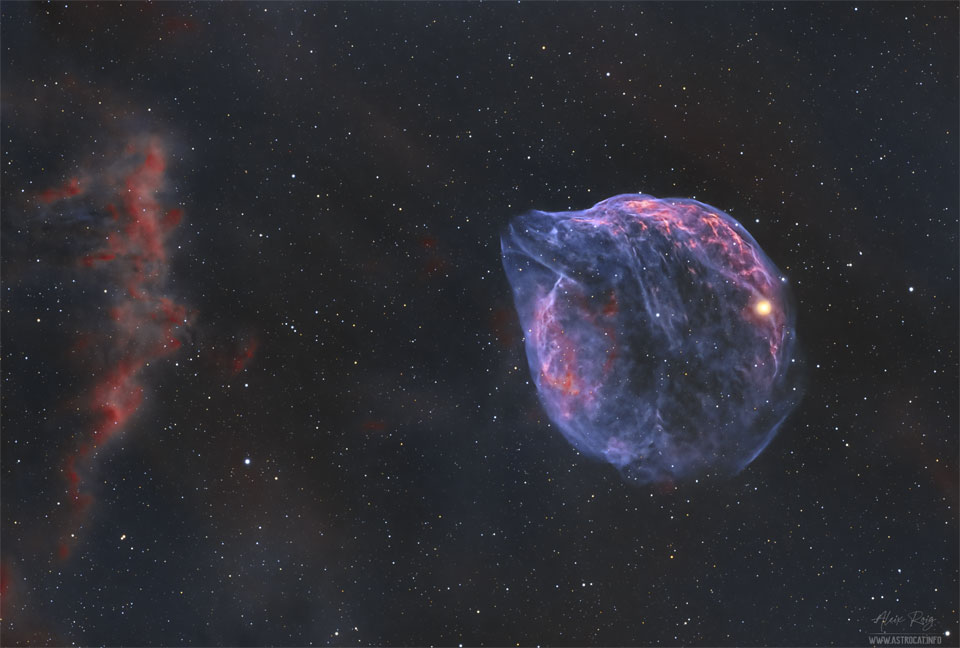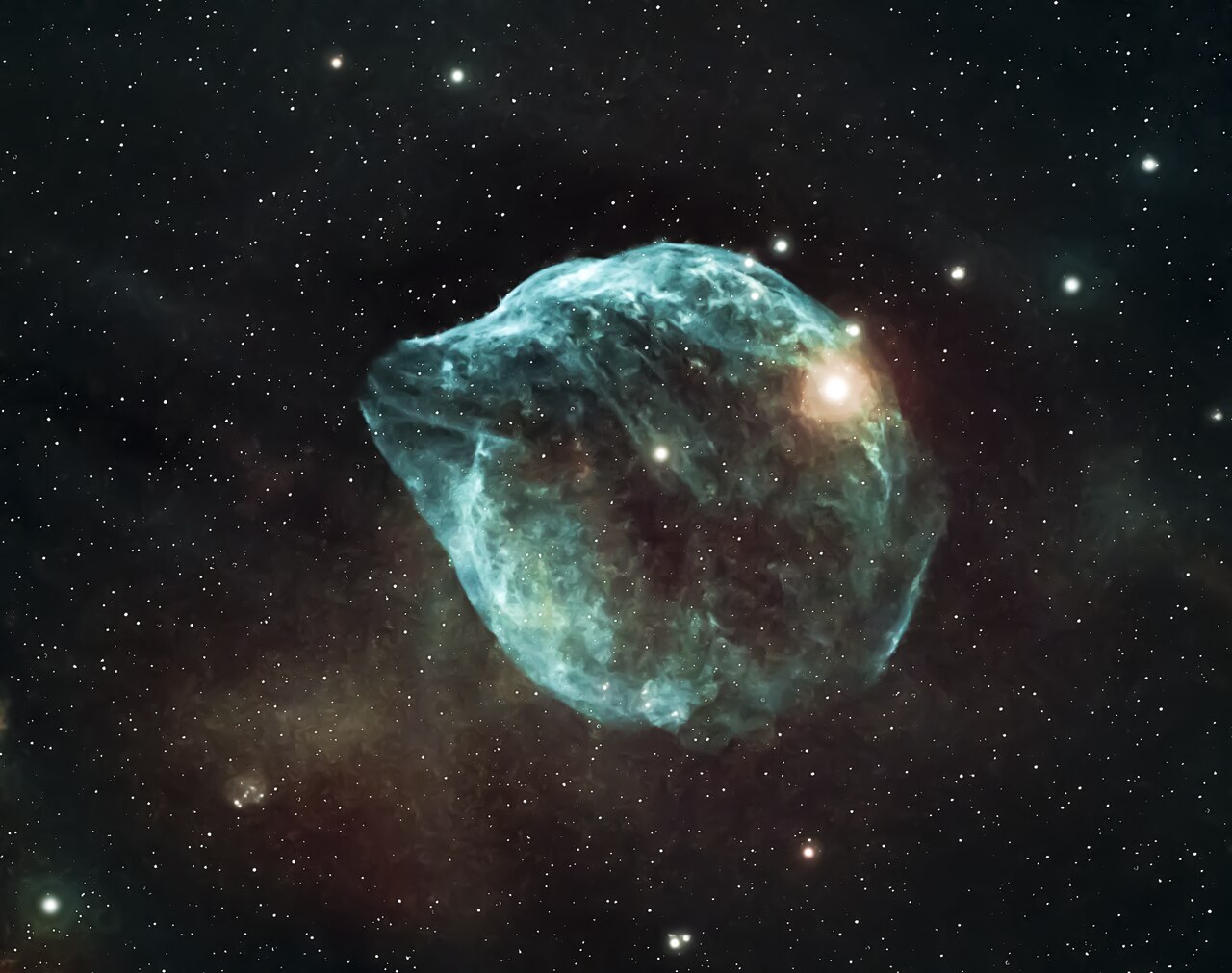I'm sorry, but pictures like today's APOD make me frustrated! What do the colors mean? What am I looking at?
In the picture at left, the Dolphin Head Nebula is mostly violet-blue, with some red bits in it. The red stuff could easily be ionized hydrogen, although it could be ionized nitrogen or sulfur, too. The violet-blue stuff is probably doubly ionized oxygen, OIII. Frankly, though, there is no way that a nebula dominated by OIII could ever look violet-blue to the eye.
In the picture at right, the Dolphin Head Nebula looks "all cyan". Well, cyan is a very reasonable color for doubly ionized oxygen. But where is the red stuff? Is there none? We do expect quite a lot of hydrogen in the dolphin-shaped nebula, because the ionizing star, EZ Canis Majoris, has cast off all of its hydrogen (into the surrounding nebula) and reveals a hydrogen-free stellar spectrum!
In the same way that I couldn't find an RGB picture of the Dolphin Head Nebula, I couldn't find a reasonable picture of the ionizing star, EZ Canis Majoris itself. All I could ever find was a lot of pictures of delphinic nebulosity with a white dot inside! All right, Simbad Astronomical Database to the rescue:
There you are. EZ Canis Majoris is a blue star, even visually blue, because it is brighter in B than in V light.
But what does the surrounding nebula really look like in RGB? Although I can't tell you, we can at least compare the Dolphin Head Nebula to another bubble nebula,
the Bubble Nebula. Let's look at two pictures of the Bubble Nebula, one RGB picture and one narrowband one with mapped colors:
The Bubble Nebula, NGC 7635, in RGB. Credit: Gaétan Thibault
Gaétan Thibault's image shows you the "true RGB colors" of the Bubble Nebula, whereas the Hubble Heritage image shows you great details of the nebula in mapped colors. The Hubble Heritage image also shows us what filters were used for the image and how the filter images were mapped. Thanks a lot for that!
Let's see what Wikipedia wrote about the ionizing stars of the Dolphin Head Nebula and the Bubble Nebula, respectively:
Wikipedia wrote:
EZ Canis Majoris (abbreviated to EZ CMa, also designated as WR 6) is binary system in the constellation of Canis Major. The primary is a Wolf-Rayet star and it is one of the ten brightest Wolf-Rayet stars, brighter than apparent magnitude 7.
(...)
The spectral type of WN4 indicates an extremely hot star, and this leads to a very high luminosity, mostly emitted as ultraviolet radiation. The spectrum shows a star entirely devoid of hydrogen at the surface.
EZ CMa is surrounded by a faint bubble nebula, a small HII region blown by stellar winds up to 1,700 km/s and ionised by the intense UV radiation. This is catalogued as Sharpless Sh2-308, or just S308. It is likely to be a member of the very scattered open cluster Collinder 121, found around the orange supergiant ο1 CMa.
Mass: 23 M
☉
Radius: 3.25 R
☉
Luminosity (bolometric): 620,000 L
☉
Temperature: 89,100 K
Wikipedia wrote:
BD+60°2522 is a bright O-type star that has produced the Bubble Nebula (NGC 7635) with its stellar wind. The exact classification of the star is uncertain, with a number of spectral peculiarities and inconsistencies between the appearance of the star itself and the effects on the nearby nebulosity, but it is undoubtedly a highly luminous hot massive star. Direct spectroscopy yields a spectral class of O6.5 and an effective temperature around 37,500 K. It is a member of the Cassiopeia OB2 stellar association in the Perseus Arm of the galaxy at about 8,500 light-years' distance.
Although BD+60°2522 is around two million years old, the surrounding nebula is apparently only about 40,000 years old. The bubble is expected to be formed as a shock front where the stellar wind meets interstellar material at supersonic speeds. The wind from BD+60°2522 is travelling outwards at 1,800–2,500 km/s, causing the star to lose over a millionth of the mass of the Sun every year.
Mass: 44 M
☉
Radius: 15 R
☉
Luminosity (they must mean bolometric): 398,000 L
☉
Temperature: 37,500 K
It's interesting to see the differences between these two hot stars that have blown nebulas around themselves. The Wolf Rayet star is very much smaller, much more energetic and
very very very much hotter than the Bubble Nebula star! 89,000 K is frankly
extremely hot, more than twice as hot as the other star! I mean, the O-star is more than
six times hotter than the Sun

, and few stars are very much hotter than that, but EZ CMa is
more than twice as hot as the O-star! Incredible!

Oh, and no, EZ Canis Majoris has nothing to do with Omicron 1 Canis Majoris, the red supergiant that is located so close to it on the sky, apparently
inside the Dolphin Head Nebula (at the right, western, edge of it). But this red supergiant star is not inside the Dolphin Head Nebula, if we are to believe Gaia. EZ Canis Majoris has a Gaia parallax that puts it at 5,000 light-years away from us, whereas the Gaia parallax for the red supergiant puts it only half as far away.
Fancy that!
Ann
EZ CMa and Omi 1 CMa, related after all?
: Okay, it
is strange that two such enormously powerful stars as Wolf-Rayet star EZ Canis Majoris and red supergiant star Omicron 1 Canis Majoris should be located
so close to one another in the sky and yet be unrelated. So I checked their proper motions with my software Guide, and they apparently have almost identical proper motions.
So could they be located close to one another after all? Gaia, can you really be so wrong?
 Sh2-308: A Dolphin Shaped Star Bubble
Sh2-308: A Dolphin Shaped Star Bubble



